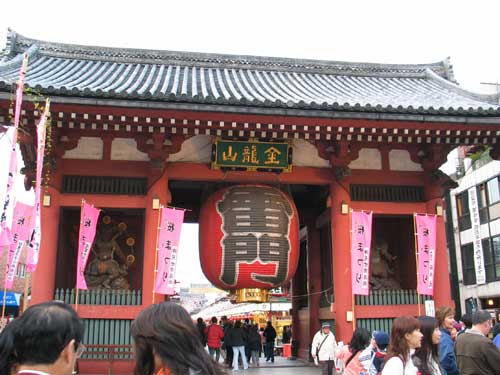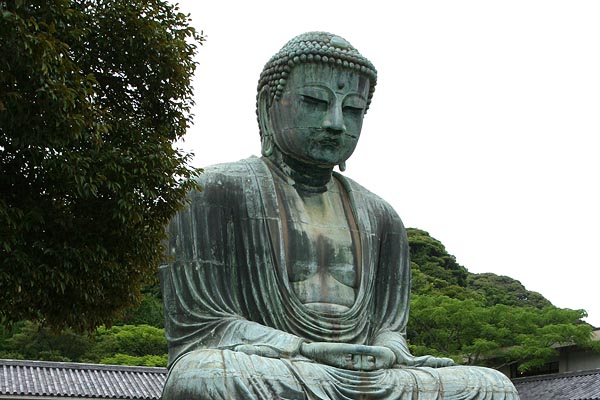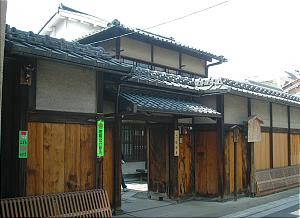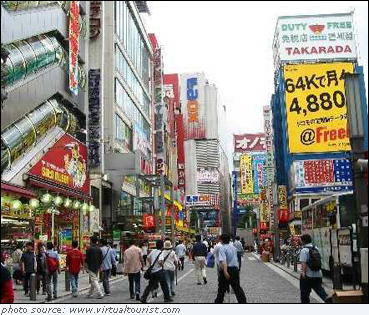10 DAYS IN TOKYO: THE BEST OFFER
Japan Travel Net introduces the newest 10 Days proposal for pleasure trip in Tokyo in Autumn 2008.
According to commercial staff's services of two
importants travel agency we're able to offer the best price for your flight and accomodation in the capital of Japan -
Of course, our Staff consultation is free!!
We works as part of a Social Promotion Association in Milan focused on Eastern Asia research and communication's projects - We'll able to arrange with you a personal solution according to your travel needs
TRIP CODE OOA: 10 UNFORGETTABLE DAYS IN TOKYO
DAY 1: Asakusa- Ueno - Akihabara

ASAKUSA: Located in Taito-ku along the west bank of the Sumida-gawa River, the Asakusa district once thrived as a temple town for the nearby Senso-ji Temple, but now it is a downtown area that rivals Ginza, Shinjuku, Ikebukuro and Shibuya. The history of Senso-ji Temple goes back far into the past. Legend has it that fishermen brothers discovered an image of Kan'non (the goddess of mercy) in the Sumida-gawa River around the year 628 and were inspired to enshrine it. The temple's symbol is the Furai jin-mon (Gate of Wind God and Thunder God) adorned with a large red paper lantern that bears the inscription "Kaminari-mon" (Thunder Gate). There is a constant flow of visitors and worshippers to the temple throughout the year.

UENO: In Tokyo Ueno-onshi-koen Park, encompassing a vast area to the west of Ueno Station, there is a concentration of cultural institutions such as: Ueno Zoo, the first zoo in Japan; Tokyo Metropolitan Art Museum; Tokyo Bunka-kaikan (Tokyo Cultural Hall); the National Museum of Western Art; the National Science Museum; and Tokyo National Museum, all offering their visitors recreation and relaxation.
AKIHABARA: The name Akihabara is now world famous. More than 250 electrical appliance and electronic shops of all sizes are located in a small area centered around Chuo-dori Street, to the west of Akihabara Station.
DAY 2: Shinjuku - Tsukiji
SHINJUKU: Shinjuku can be roughly divided into three areas: the West Exit area, an office town with a row of high-rise buildings such as the Tokyo Metropolitan Government Office Building; the South Exit area, a newcomer to Shinjuku with complex establishments for shopping and amusement; and the prominent entertainment district around Kabukicho, a town that never sleeps. In the East Exit area there is a row of department stores and other large stores, all of which are integrated and linked together.
DAY 3: Yoyogi, Harajuku, Shibuya
HARAJUKU: Harajuku is a collective term for the area that stretches from the south of the Sendagaya area to Jingumae-machi. On the west side of JR Harajuku Station is Meiji-jingu Shrine, located in a forest, it is famous for its Japanese iris garden where irises bloom in profusion during the rainy season, and a treasury hall that stores articles that belonged to Emperor Meiji, the highly cherished emperor of the late 19th century. Near Meiji-jingu Shrine is NHK Broadcasting Center, where visitors can take a tour through the TV program studios and view various exhibits.

Shibuya is unique in that every street and area in the district has a completely different atmosphere. The Shibuya Center Street is crowded with a multitude of shops, including youth fashion shops, fast food restaurants, and game centers, and it is famous as the place where new trends are born that quickly spread among the youth nationwide. It is always crowded day and night, mostly with teenagers, and you can get a direct feel for today's Japanese fashion trends there.
DAY 4: Roppongi - Akasaka

ROPPONGI :The Roppongi district is filled with popular nightspots packed with visitors from abroad. There are also many international restaurants, so it should be easy to find something to suit your taste. Two popular attractions in Roppongi are Roppongi Hills and Tokyo Midtown. On the 53rd and uppermost floor of Roppongi Hills, you will find contemporary art exhibited in the Mori Art Museum, and on the 52nd floor is Tokyo City View where the glass-walled observatory offers a stunning 360-degree view of the city, particularly impressive at night. Tokyo Midtown has art venues, such as the Suntory Museum of Art, and a large garden. Both Roppongi Hills and Tokyo Midtown have many restaurants, brand name shops and hotels offering various kinds of entertainment.
AKASAKA: The Akasaka district has many first-class hotels and foreign embassies. It is another famous nightspot like Roppongi, however, Akasaka is characterized by its exclusive clubs and excellent Japanese restaurants. There are many faces to Akasaka: its political face as home to the Diet Building and the Prime Minister's Official Residence
DAY 5: Central Tokyo

CENTRAL TOKYO: Kasumigaseki, in Chiyoda-ku, has developed as the center of the national government since the Ministry of Foreign Affairs and other government ministries and agencies of the new Meiji Government were established there. The central government was restructured after the end of the WWII, and almost all ministries are now located in the area. In Nagata-cho, to the west of Kasumigaseki, stand the Diet Building, the Prime Minister's Official Residence and the National Diet Library. This is the core area for the administration and politics of Japan. To the east of the office area of Marunouchi lies the current Imperial Palace. Located on a vast site where Edo Castle once stood, it is surrounded with stone walls and moats. While visitors are not allowed to go inside the palace itself, three places are open to public, namely Kokyo Gaien (Imperial Palace Outer Garden), Kokyo Higashi Gyoen (Imperial Palace East Garden) and Kita-no-maru-koen Park.
DAY 6: YOKOHAMA TRIP

YOKOHAMA: In the mid-19th century, the American Commodore Matthew C. Perry and his fleet arrived in Japan to establish treaties of friendship between Japan and the Western world. Japan's isolation from the rest of the world, which lasted for more than 200 years, was finally over. Yokohama Port was immediately opened for international trading and soon became crowded with Western traders. Many Chinese were also brought into Yokohama to help communication between the Japanese and the Westerners, and that was the beginning of the Chinatown in Yokohama. Now, the Chinatown in Yokohama has become one of the largest in the world, with more than 500 stores.
DAY 7: KAMAKURA - Visiting ancient Japan closer to Tokyo

: Kamakura City is situated in the southeastern part of Kanagawa. One side of the city faces the sea and the rest is surrounded by mountains, so it was used as a natural fort. The Shogun Minamoto-no-Yoritomo established his shogunate (the center of politics) in Kamakura, in 1192, leading samurai warriors of the Kanto region. The city prospered for more than 150 years from that time. There are many historical sites for sightseeing, mainly temples and shrines that are scattered around in this city. Walking through greenery from site to site adds pleasure to a sightseeing tour. A good starting point for exploration is Kita-Kamakura.
DAY 8: Vip Shopping in Ginza, Enjoying Disney Resort, Night Panoramic View in Odaiba

GINZA: It encompasses an area from 1-Chome (block) to 8-Chome, where well-established Japanese shops and famous brand name shops from around the world stand side by side on Chuo-dori, the district's main street, Namiki-dori which runs parallel to Chuo-dori, Suzuran-dori and other streets. The Kabuki-za Theater, where the Japanese traditional theatrical art known as "Kabuki" is performed, is located to the west of the intersection at 4-Chome, on the way towards the neighboring Tsukiji district.
ODAIBA:The center of Odaiba is Aquacity Odaiba. It includes a shopping mall with a 300-meter-long boutique street, a multi-flex cinema that employs the latest acoustic and screen technologies, and a gourmet zone that stretches over 15,000 square meters, which is obviously the largest such zone in Japan.
Major attractions of Odaiba are dotted along the Yurikamome Line, a new unmanned traffic system that crosses Rainbow Bridge to connect Shimbashi Station with Odaiba. Attractions include the Odaiba Seaside Park that overlooks Rainbow Bridge, Fuji TV headquarters and studios where visitors can see the sets of popular TV programs, and Palette Town, a "theme park for women" with an interior modeled after a European city in the 18th century, and which accommodates over 150 shops. All of these and many other vie against each other in one location.
DAYS 9 - 10: SEEING NIKKO

lies at the foot of Mt. Nyoho-san in the western part of Tochigi and it has developed as the temple town for Futara-san-jinja Shrine, Toshogu Shrine and Rin-no-ji Temple. There runs the Nikko-Suginamiki-Kaido (Nikko's Japanese- cedar-lined Road), which is designated as a natural monument. And the city forms a part of the Nikko National Park.Toshogu Shrine is where the famous Shogun of the Edo Period in the 17th century, Tokugawa Ieyasu, was worshiped after his death. It became as luxurious and elaborate as it looks today when the grandson of Ieyasu, the third Shogun Tokugawa Iemitsu, reconstructed it. The engravings on the Yomei-mon Gate are especially overwhelming, provided with every luxury imaginable and redolent in gorgeous colors. The engravings of the three monkeys in Shinkyu-sha and the statue of Nemuri-neko, the sleeping cat, are also well known.
TOUR'S SERVICE DETAILS
- Direct Flight from Europe: Milan, Rome, London etc - JAL service
- Accomodation in 4 stars Hotel or Ryokan - Western Style or Japanese Style according to your request
- Insurance consultation and travel, health, lagguage Insurance Policy included
- Help Call Center and direct support line
- Rapid intensive japanese course in Milan or Rome before departure - (Courses are arranged in collaboration with Asian Studies Group, multidisciplinary association and with mothertongue staff)
- Bilingual support staff in Tokyo
- Price: 1700 - 1850 euro -
- Discount prices available for groups or students!
- For further information please feel free to contact us
Italian Version - Presentazione in Italiano
PROGRAMMA DI SOGGIORNO A TOKYO
Proposte di alloggio (Tokyo)
Asakusa / Ueno / Nippori: molto vicine a Narita e ben collegate con mezzi
Shinjuku: cuore della capitale - Trasferimento diretto Narita by bus
Shinagawa: sud della capitale, collegata direttamente da Narita EXP e comoda per trasferimenti su Haneda e by Shinkansen
Tour su Tokyo
GIORNO 1: Asakusa - Ueno - Akihabara: fra Giappone d’epoca Edo e stranezze high tech
GIORNO 2: Shinjuku: blade runner alla giapponese - fra grattacieli e centri commerciali - Pomeriggio a Tsukiji
GIORNO 3: Una giornata da teenagers, follie da shopping, partendo da Shibuya al vintage trash di Harajuku, passando per il parco della musica di Yoyogi
GIORNO 4: Passeggiate da gaijin ai piedi della Tokyo Tower: Roppongi - fra locali, musei d'arte contemporanea e divertimento
GIORNO 5: Visita all’Imperatore: passeggiata nei dintorni del Palazzo visitando gli enormi Giardini imperiali -Tokyo - Rinfresco ad Hibiya Koen
GIORNO 6: Viaggio a Yokohama - Atmosfere cinesi, fra architetture d’avanguardia e spazi verdi sulla baia del porto di Yokohama
GIORNO 7: Uscita a Kamakura - Il giappone dei Samurai e dei monaci a due passi dalla capitale
ULTIMO GIORNO A TOKYO: Un arrivederci da sogno. Colazione da Vip e passeggiata extralusso a Ginza. Pomeriggio di divertimento al Disney Resort e cena romantica sulla baia - Odaiba
GIORNO 9 e 10: Visitando Nikko. A poche ore da Tokyo una delle bellezze storiche e artistiche del Giappone. Protetto dall'Unesco come patrimonio dell'umanità, una passeggiata fra templi e natura. Tappa alle onsen del complesso monumentale di Nikko-
DETTAGLI DEL PROGRAMMA
- Volo diretto da Milano con servizio JAL
- Alloggio in hotel 4 stelle stile occidentale o ryokan giapponese high class secondo vs esigenze
- Consulenza assicurativa e polizza di viaggio, bagaglio e sanitaria inclusa
- Linea diretta d'informazione con staff preparato
- Staff di supporto a Tokyo, bilingue
- Corso intensivo di giapponese (Il corso rapido è organizzato grazie al supporto dell'Associazione Asian Studies Group e si tiene presso la sede di Milano / Roma)
- Prezzo: 1700 - 1850 euro tutto incluso - possibilità di servizio low cost 1500 euro!! (solo per accomodation 3 stelle)
- Sconti disponibili per gruppi e studenti







.jpg)












.jpg)









